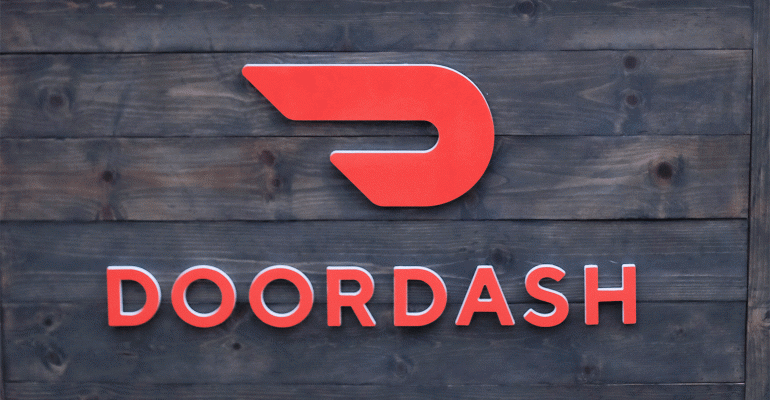Third-party delivery leader DoorDash has created the role of chief revenue officer, a position that will work directly with restaurants to ensure their success on the platform.
Former YouTube executive Tom Pickett started March 31 in a role that was created before the COVID-19 pandemic. Pickett will oversee DoorDash’s effort to innovate on ways to better serve restaurants, which became priority No. 1 when he started during the beginning of the pandemic.
“I'm super excited to be joining DoorDash, particularly in this moment, because of the impact DoorDash is having helping merchants through this challenging time,” Pickett, who previously worked as vice president of content and operations at YouTube, said in a DoorDash blog post released Wednesday.
DoorDash is shoring up its executive team at a time when the COVID-19 pandemic has turned up the heat in the hyper-competitive third-party delivery space. The sector, which includes Uber Eats, Grubhub and Postmates, has grown more competitive during the pandemic as delivery is one of the few channels restaurants can use to earn revenue with dining rooms shutdown.
In an exclusive interview with Nation’s Restaurant News, Pickett talked about DoorDash’s strategies as restaurants begin to reopen dining rooms, consolidation in the industry, and commission fees.
Tailored approach
 DoorDash, often viewed in the industry as the most “restaurant friendly” delivery operator, is constantly bringing new products to market to serve restaurants. It’s Pickett’s role to work with restaurants, which the company refers to as merchants, to ensure they are set up for success.
DoorDash, often viewed in the industry as the most “restaurant friendly” delivery operator, is constantly bringing new products to market to serve restaurants. It’s Pickett’s role to work with restaurants, which the company refers to as merchants, to ensure they are set up for success.
Often that could mean a more tailored approach.
“I think when you manage a large number of partner relationships, you'll have a standard offering, which the majority of restaurants will hopefully find appealing. Certainly, we look to introduce new products as we go forward and find the right products for the right restaurants,” he said.
Relief focused on the most vulnerable
DoorDash has directed most of its pandemic relief to small independent restaurants, which Pickett says are “the ones that we felt were the most at risk of going out of business.”
DoorDash cut commission fees by 50% for independent restaurants that have five or fewer locations on the app. Early on, the company was waiving commission fees for a month for new mom and pop restaurants on the app. The San Francisco-based company also offered a free delivery promotion on Saturday aimed at helping indie concepts.
The company said, in total, it has invested $100 million in helping independent restaurants.
“I'm really proud of what DoorDash has done on the relief front,” he said. “That was a big move from a leadership perspective. No other third party platform has done something as aggressive as what we did. And we did that because we were hearing that restaurants were having challenges and we're looking for relief across the board.”
How do you keep new restaurants from leaving the platform?
The privately-held DoorDash, which has 340,000 restaurants on its platform, declined to provide details on order volume during the pandemic.
DoorDash acknowledges that restaurants that never wanted delivery, including fine dining restaurants, have signed up on their platform.
But as dining rooms reopen, will the new normal still include these restaurants?
Pickett believes it won’t be a temporary move as full-service restaurants will still have to balance off premise with on premise in the next phase of COVID-19.
“My expectation is dine-in will take some time to ramp up to what it was. And those restaurants will continue to stay on the platform,” he said.
Restaurants will find that delivery is “additive” to their business and it can co-exist with dine-in, he added.
“I think we're gonna find ways they can do both. So that's my hypothesis. We'll see. But I don't anticipate people jumping off the platform in the short future. And I hope that they stay on perpetually.”
Commission fees vary
The COVID-19 pandemic has put delivery commission fees in the spotlight, with restaurant advocacy groups and city leaders advocating lower fees to give restaurants a fighting chance to survive amid mandates that allow venues to only serve customers through off-premise channels, including delivery.
Pickett addressed how those fees are used, and the challenges of a one-size-fits all approach.
Commissions, he said, vary because they pay for a combination of fixed costs such as paying drivers, protective equipment and credit card transaction fees.
The commission also pays for “creating demand” for each restaurant on the platform, or what the industry calls the marketplace.
That’s the challenge of commission caps, he said.
“We do have different deals in place with restaurants where they want to pay more to get more” marketing, he said.
Rival Grubhub makes the same argument.
“And the more you put a fixed constraint on the system, you actually reduce flexibility for both restaurants and for the whole ecosystem,” Pickett said.
“We're trying to do the right thing. We continue to listen to the restaurants, and we're trying to figure out the best way to help them on the next wave as we start to move into the opening a restaurant phase,” he said.
Consolidation in the industry
Sector consolidation has been rumored for months. In recent weeks, several media have reported that Uber, the parent company of No. 2 player Uber Eats, is in pursuit of Grubhub.
That would slice into DoorDash’s market share dominance in the space.
According to the latest data from ecommerce research firm Edison Trends, DoorDash has dominated market share in the delivery space for more than a year. The company’s market share in April, based on transactions, was 45%, ahead of Uber Eats (28%) and Grubhub (17%).
Pickett said DoorDash is not focused on rivals merging. Insead, the company's mission is to be “customer obsessed, not competitor focused,” he said.
“That's the way we operate. And it's led to great success up to this point. So, we're going to continue to focus in on the restaurant needs, and hope the rest works out for itself,” he said.
Contact Nancy Luna at [email protected]
Follow her on Twitter: @fastfoodmaven

